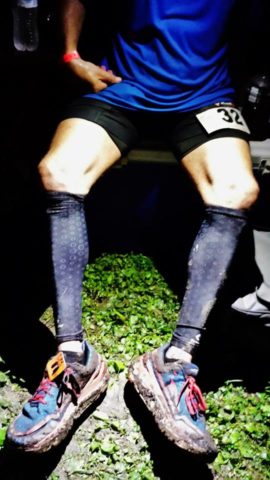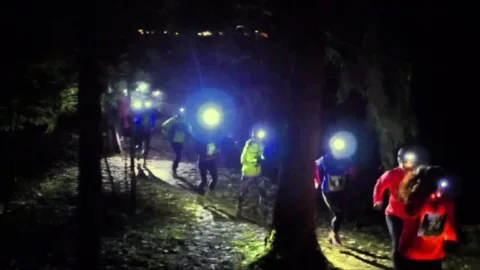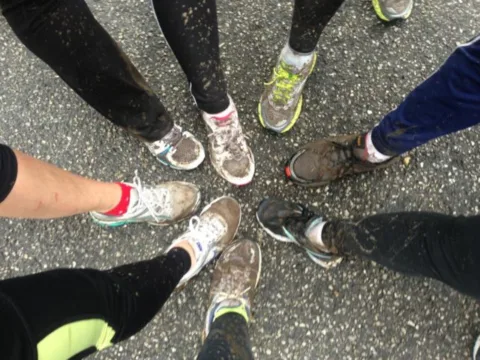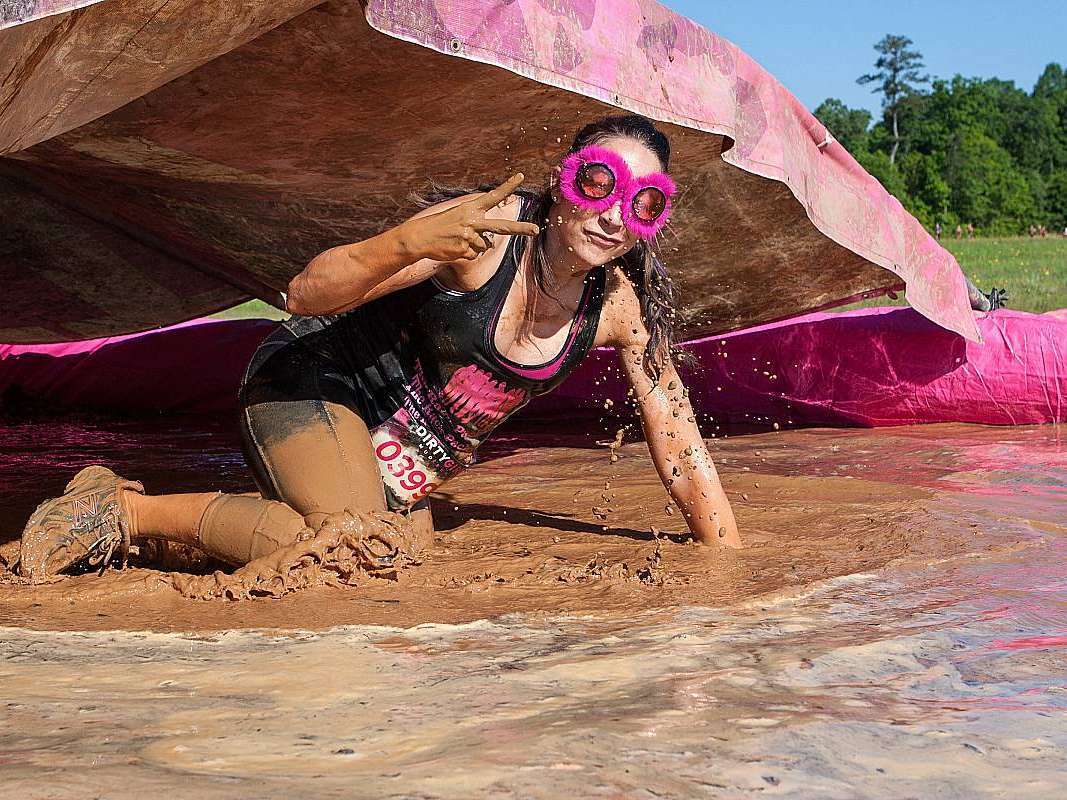I recently placed 4th in the Ozone Endurance Challenge 24-hour trail ultramarathon.
The conditions were difficult with heavy downpours and storms — which made the trail treacherous and mostly mud. Given the conditions, I was happy to have run 80 miles.
If you’ve already signed up for a 24-hour ultramarathon or you’re considering it, I hope you find the following lessons that I learned at Rockwood to be useful.
Before You Do A 24-Hour Run…
Once you get going into ultramarathons it doesn’t take long before you start noticing that:
- Some races are distance oriented — like 50 or 100 miles
- Others are timed races — such as 6, 12, 24, 36 and 48 hours
The idea with timed races is to tackle the time-length and see how many miles you can run in that period. Once you get into the higher mileage or timed races, you will be running during the nighttime hours.
The 24-hour ultramarathon has become particularly popular. I’ve decided to share my best tips and recommendations based on my own experience in running 24-hour ultramarathons.
So, you want to run a 24-hour ultramarathon? Here are a few things to consider…
#1 – Run 6’s and 12’s first.
There are 6-hour and 12-hour timed ultramarathon races. Do those first.
If you’ve run a 50-mile ultramarathon, it’s likely you have already done a 9 to 12 hour run, and so signing up for a 24-hour run is reasonable.
What you don’t want to do is jump too quickly to a 24-hour ultramarathon if you’ve never done a run longer than 6 hours.
Doing a 12-hour ultramarathon would be great prep for the 24-hour. Many 12-hour ultramarathons give you the option of running at night (8pm to 8am) — so you get the experience of nighttime running.
The 6-hour run is a good idea, but optional. However, I would recommend doing a 12-hour ultramarathon before tackling the 24-hour run.
#2 – Think about time on your feet.
Most runners are trained to think about distances. It is also useful to think of time on your feet.
There are some training sessions where I run a distance – 6, 12, 20 miles. There are other training sessions where I think time on my feet.

For example, in training for Rockwood I did several 7 to 9 hour training sessions. In other words, I told myself I’m going to spend 7 to 9 hours running and walking.
The point is to stay on your feet and keep moving forward for that length of time. I also did a couple back-to-back timed training sessions — I did 6 to 7 hours on Saturday, and then followed it up with 6 to 7 hours on Sunday.
Most runners don’t realize the importance of doing training that involves walking. Unless you are an elite ultrarunner, you’re going to have to employ a run/walk strategy when it comes to the ultra distances and multi-day races.
Walking is not something you do when you can’t run anymore. It’s a strategy for covering more miles in your allotted time.
Walking involves a different set of muscles – you have to incorporate walking into your training.
#3 – Get geared up.
Most runners think of running gear as mostly running shoes and apparel and a sports watch.
But when you start getting into 24+ hour ultramarathons, gear like headlamps, tents, canopies, backpacks, camelbaks, coolers, and first-aid supplies become super important.
Fastpacking is also something to be explored as you consider multi-day races.
An important rule of thumb is never use gear for the first time at the actual race. Do training runs with that headlamp, camelback or backpack and put up that tent or canopy once in your backyard before the race so you know how it works and goes up.
You don’t want any unnecessary surprises with your gear on race day. The longer the ultramarathon, the more gear issues come into play — and you want to be sure to cover all the bases!
#4 – Do what sucks.
Your physical strength and endurance will take you a certain distance, and then it’s up to your mental toughness to press on, endure, and finish.
The conditions at Rockwood were not pretty – heavy rain, storms, and a washed out and muddy trail. There were some runners who called it quits. I don’t blame them. Honestly, it was sort of insane trying to stay upright, running through pouring rain and shin-high mud in the middle of the night.
But that’s the point. You do it. You just keep running. It’s damn the torpedoes full speed ahead! You tell yourself there are only 2 options — death or finishing — and that even death isn’t really an option because you have kids and stuff.
Mental toughness training is important for running a 24+ hour ultramarathon. With the exception of brief breaks at the aid station or personal staging area, you are running or walking the entire 24 hours.
Do some training sessions that help build mental toughness. If it doesn’t suck, it’s not building mental toughness.
#5 – Have some peeps.
You really don’t want to train for and run a 24-hour ultramarathon alone.
In several of my 7-hour training runs, a running friend would meet up with me about 4 hours into it. I’d run the first 4 hours on my own and the last 3 with him. That really made a big difference.
At Rockwood when I did the 24-hour run, he did the 6-hour run — and it helped to see and talk with him during that time period.

Many people who do 24+ hour runs have a support crew of 1 to 3 people who come out and stay for the duration of the race. They set up a tent or canopy and are there to offer moral support, first-aid, a few comforts, and any specialized food or hydration preferences of the runner.
Whether it’s a training partner or just family or friends who are willing to support you, it’s good to have your own running posse who will be there for you.
#6 – Surface matters.
Many long-distance or timed ultramarathon races (100+miler/24+hour) are typically done in small loops of 2 to 3 miles. The purpose of this is to bring you around to the aid station frequently — so you have the fuel and hydration to support your long run.
Because the course is done in these small loops, people are prone to not think to seriously about the running surface. You might think, “Road, pavement, trail, whatever… it’s just a couple miles.”
However, it makes a difference.
If you train solely on a hard surface — such as road or pavement — you may be in for a rude awakening if your ultramarathon race is on a trail. Your ankles and joints may not be prepared and able to handle such a course for a 24-hour duration.
Find out what the course surface is. Sometimes the course pictures show only the nice flat sections and not the hilly and gnarly sections. A “trail” doesn’t mean it’s a path of nice comfy wood chips.
Find out how technical the course is. Even if it’s a 2-mile loop, that loop could include sections of rocks, stumps, roots, and small but challenging inclines and declines — especially when you’re 18 hours into your 24-hour run.
Know everything you can about the course and the surface, and make sure you do some of your training on that kind of course.
#7 – Beware the chair.
If you’re running 24 hours, you need to stop every now and then and rest. You know… sit down, kick back, lift your feet up, and chill. Right? Not!
Beware the chair. It has claimed many ultrarunners who sat down, got a little too cozy, and never got back up.
When it comes to a 24-hour ultramarathon, think in terms of moving forward 95% of the 24 hours. That means out of 24 hours, 1.2 hours you won’t be moving forward. During those 1.2 hours you will be fueling up and hydrating at the aid station, using the restroom, changing clothes, and other related things.
If you break down your 24-hour race into four 6-hour races that means you have 20 minutes of not moving forward per 6-hours. That doesn’t necessarily mean you are running the other 23 hours. It may also include walking. The main thing is to keep moving forward.
Use your stoppage time strategically and wisely. Don’t forget that you can take in fuel and hydration as you run a slower pace or walk.
Stopping for longer than 5 to 6 minutes makes it more difficult to get back to it. Just keep moving.
#8 – Have an extra headlamp.
In the middle of the night during my 24-hour Rockwood run my headlamp died, and it was suddenly pitch dark. I could not see 2 feet in front of me. Lucky me, I was carrying an extra one.
Have an extra headlamp. I always carry 2 headlamps at night – the one on my head and the one in my pocket:
- One of my headlamps is a more high-tech and expensive lamp with a rechargeable battery.
- The other one is a more basic and cheaper headlamp that uses AAA batteries. It comes in handy since you can’t recharge a more sophisticated headlamp during your run. However, you can keep plugging in new batteries to your cheaper one, if necessary.
Bring extra batteries. Bottom line: have a backup plan for the lighting you need for the night portion of your run. You might even consider bringing a flashlight if all else fails. Stuff happens.
#9 – Stick to the plan.
First, have a plan for your 24-hour ultramarathon.
My plan was breaking down the 24 hours into four 6-hour races. I knew the course had some hills and so my run/walk strategy was to run the flats and walk the hills. I also planned to do a change of clothes after each 6-hour segment. It put me in dry clothes and gave me a little pick-me-up for each period.
Think through these kinds of clothing issues. I had 4 changes of shirts, shorts, and socks. I also had 2 pairs of running shoes — and used both of them.
I also had a strategy for my fuel and hydration, and my strategic stoppage breaks. I even planned to have my favorite meal and dessert ready to eat for dinner for a little feel-good reward. I checked in advance if coffee would be available at the aid station, so I could have a few brief coffee breaks during the day and night running hours.
Think through every detail and have a plan for how you’re going to manage your 24-hour run. Stick to it! Don’t let the adrenaline, race atmosphere and hoopla, or other runners distract or pull you out of your plan.
You have a plan for a reason. Stay focused. Stick to it.
#10 – Screw the plan.
I had a great plan for Rockwood. And then stuff happened — like heavy rain, intense storms, washed-out trail, and muddy flats. Twenty sets of dry clothes and shoes wouldn’t have mattered in those conditions. I was drenched with rain and covered in mud.
My run/walk strategy became undoable because some of the flats were too treacherous and muddy to run. Some of the food items I had specially prepared and brought with me to eat during the race lost their appeal and I didn’t want to eat them. I also got to a point when I couldn’t stomach the aid station sports drinks anymore.
I had great intentions about updating my race experience with friends and followers on Facebook, Twitter, and Instagram — but then had to pack away all my electronics to keep them from getting wet.
So I just said, screw the plan! The new plan was courage, guts, survival, adjustments, adapting, improvisation, doing what works, sucking it up, accepting what is, and keep moving forward.
The plan was damn the torpedoes, full speed ahead. Have a plan, yes. But sometimes your plan goes out the window, and what happens next is what makes you into a true blue ultrarunner!
#11 – Be a person of goodwill.
You develop a bond with other runners over the course of a 24-hour run in treacherous conditions.
I remember during some of my most difficult moments, there always seemed be another runner passing by who offered an encouraging or affirming word, flashed a reassuring smile, or expressed some other gesture of solidarity and support.
Be that person. Be a person of goodwill. Yes, of course, you have your race goals and your PR you’re trying to hit, but also get outside your personal agenda and embrace the humanity of the event.
During my 24-hour run I felt and shared so many profound and poignant human moments. We cried together. We laughed together. We hurt together. We endured together. We celebrated together. We actually came to care about each other. I made several new friends during my 24-hour run at Rockwood, and since then we have connected together and stay in touch through social media.
My life has been greatly enriched because of these friendships and connections. I’ve grown to care not just about my own running pursuits and successes, but those of other runners.
Ultrarunners – we are a community, a tribe; we’re family. We just keep running. Yes, we’re a little crazy. Okay, a lot crazy. Most of us have big hearts. We care about each other.









